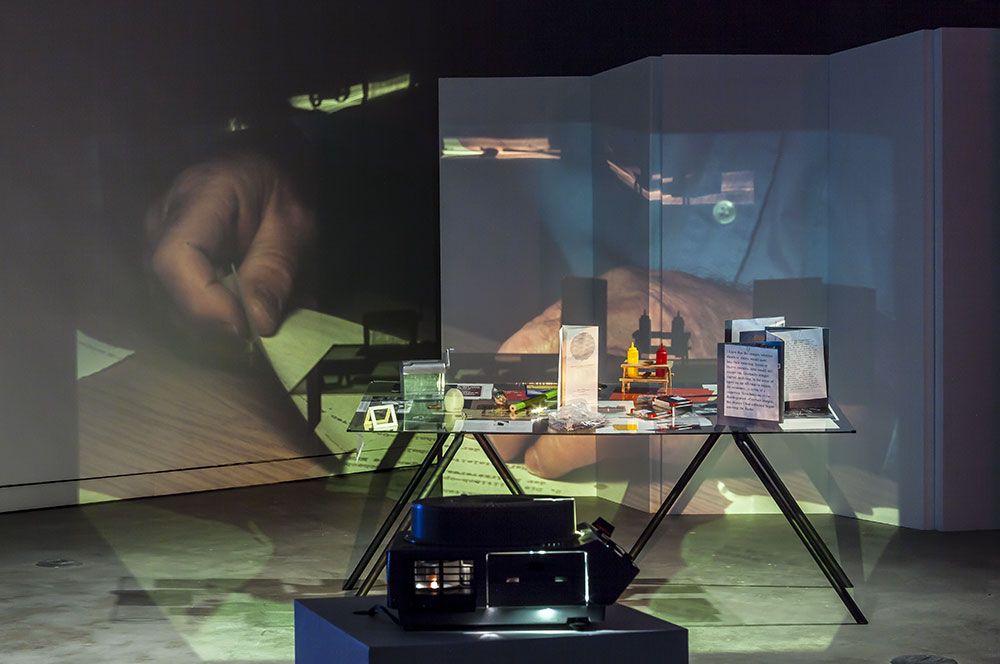
Tris Vonna-Michell
2014.02.07 - 04.12
Overflowing history
YUKI HIGASHINO
A photograph is never alone: one can locate it at the intersection of the social, personal and historical contexts in which it was taken. It has a story, or several of them. Neither is a photograph ever simple, because the context of its taking—any context—is never simple. It is practically impossible to fully explain the political, economical, emotional, legal and/or æsthetic circumstances that resulted in the act of taking that picture. Moreover, the photograph’s relationship to other photographs is infinitely expansive.
One could argue that the practice of Tris Vonna-Michell is an attempt, on the one hand, to accurately describe the bewildering complexity that lurks behind photographs, and, on the other hand, to give forms to the endless information such pursuit inevitably generates. In his intricate interplay between spoken words (performed or recorded), photography (as slides or printed), text (often overlapping with, but never identical to, the voice[s]), objects and interiors (fish tank, memorabilia, furniture, etc.), Vonna-Michell tirelessly tries to make sense of the ever-shifting context in which his, and archival, photographs were/could be taken, and stories written. Though many of his works have clearly autobiographical traits, these are not employed in order to authenticate and legitimize the works, as is the case in confessional artworks. Rather, the artist’s subjective experiences function as anchorages for grasping the multifaceted socio-political and cultural-historical constellations in which certain imageries can be produced. To take one example, in his Finding Chopin, private anecdotes such as a conversation with his father are woven together with a history of post-war experimental poetry personified in the figure of Henri Chopin, the urban development of London and expansion of its metropolitan area, or the cityscape of another city, Paris, among other threads. Vonna-Michell’s works are both historical study and social observation, filtered through his personal experiences. He eschews the pretence of objectivity in favour of acknowledging his implication in the situation he narrates. He is implicated as an artist (tied to cultural history), as an individual (who, like anyone else, is unable to completely exclude emotional responses) and as a citizen (tied to politics and economy). This implication manifests in his formal language, in that the artist uses his own voice, or his pictures are normally taken without a tripod, for instance.
It is significant that Vonna-Michell’s pictures are always in groups, most often presented as slide shows, highlighting each image’s incompleteness on its own. And the rapid, fragmented and compressed delivery of the narrative along with the research that have generated his works point to the vastness of the context in which a person exists. The severe reduction of the story to nearly abstract performances/recordings, informed by the methodologies of experimental literature, consequently addresses the extreme inadequacy of language and other forms of representation in conveying one’s experience and its social circumstances.1 Reflecting, really, attentively, on the images taken during the experience of following a somewhat tenuous familial connection with an experimental poet produced the overwhelming amount of notes, ideas, data and stories contained in Finding Chopin. One can only imagine, then, the immensity of material that was generated when this meticulous reflection was applied to subjects with larger social reverberation, such as Le Corbusier’s architecture for the Indian regional capital Chandigarh, and the politics around its realization (Capitol Complex).
This vastness of knowledge generated through research and reflection leads to another characteristic of Vonna-Michell’s practice; namely, the high degree of control. There is strong presence of mechanical apparatuses such as slide projectors programmed to be in synch with audio, objects painstakingly arranged in spaces with carefully chosen furniture, and texts presented with precise graphic design. They strictly regulate time and space. The clicking sound of the slide projectors and highly skilled delivery of text hint at the existence of a thoroughly considered system. Every formal decision is significant, as utmost precision is required to contain and communicate the limitlessness that society and history reveal when investigated with a rigour (or perhaps obsession) such as Vonna-Michell possesses. Each exhibit is a variation, reflecting the conditions that the work, ever conscious of its context, faces at the particular moment in history in which it is exhibited.
1. An interesting historical comparison could be Spalding Gray, whose practice was an important precedent to Vonna-Michell’s but employed a diametrically opposite method. In the iconic Swimming to Cambodia, Gray’s experience playing a small part in a Hollywood film about the Khmer Rouge genocide resulted in a four-hour monologue that touched upon his neurotic private life, Cold War politics, and Cambodian history, among many other things.